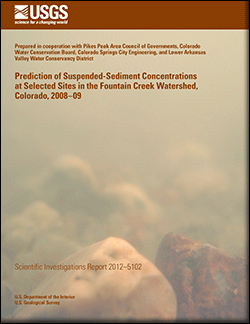- The document and additional supplemental information are available at the index page for this publication
- Full-text PDF
Abstract:
In 2008, the U.S. Geological Survey (USGS), in cooperation with Pikes Peak Area Council of Governments, Colorado Water Conservation Board, Colorado Springs City Engineering, and the Lower Arkansas Valley Water Conservancy District, began a small-scale pilot study to evaluate the effectiveness of the use of a computational model of streamflow and suspended-sediment transport for predicting suspended-sediment concentrations and loads in the Fountain Creek watershed in Colorado. Increased erosion and sedimentation damage have been identified by the Fountain Creek Watershed Plan as key problems within the watershed. A recommendation in the Fountain Creek Watershed plan for management of the basin is to establish measurable criteria to determine if progress in reducing erosion and sedimentation damage is being made. The major objective of this study was to test a computational method to predict local suspended-sediment loads at two sites with different geomorphic characteristics in order to evaluate the feasibility of using such an approach to predict local suspended-sediment loads throughout the entire watershed. Detailed topographic surveys, particle-size data, and suspended-sediment samples were collected at two gaged sites: Monument Creek above Woodmen Road at Colorado Springs, Colorado (USGS gage 07103970), and Sand Creek above mouth at Colorado Springs, Colorado (USGS gage 07105600). These data were used to construct three-dimensional computational models of relatively short channel reaches at each site. The streamflow component of these models predicted a spatially distributed field of water-surface elevation, water velocity, and bed shear stress for a range of stream discharges. Using the model predictions, along with measured particle sizes, the sediment-transport component of the model predicted the suspended-sediment concentration throughout the reach of interest. These computed concentrations were used with predicted flow patterns and channel morphology to determine fluxes of suspended sediment for the median particle size and for the measured range of particle sizes in the channel. Three different techniques were investigated for making the suspended-sediment predictions; these techniques have varying degrees of reliance on measured data and also have greatly differing degrees of complexity. Based on these data, the calibrated Rouse method provided the best balance between accuracy and both computational and data collection costs; the presence of substantial washload was the primary factor in eliminating the simpler and the more complex techniques. Based on this work, using the selected technique at additional sites in the watershed to determine relative loads and source areas appears plausible. However, to ensure that the methodology presented in this report yields reasonable results at other selected sites in the basin, it is necessary to collect additional verification data sets at those locations.
|
Additional Publication Details | |
|---|---|
| Publication Type | USGS Numbered Series |
| Title | Prediction of suspended-sediment concentrations at selected sites in the Fountain Creek watershed, Colorado, 2008-09 |
| Author | Stogner, Robert W., Sr.; Nelson, Jonathan M.; McDonald, Richard R.; Kinzel, Paul J.; Mau, David P. |
| Year | 2013 |
| Series | Scientific Investigations Report |
| Series Number | 2012-5102 |
| Language | English |
| Publisher | U.S. Geological Survey |
| Publisher Location | Reston, VA |
| Contributing Office | Colorado Water Science Center |
| Description | vii, 36 p. |
| Online Only | Y |
| Lat Bound N | 39.1359 |
| Lat Bound S | 38.2387 |
| Lon Bound E | -104.2369 |
| Lon Bound W | -105.0753 |
| Country | United States |
| State | Colorado |
| Additional Location Information | Fountain Creek Watershed |
| Projection | Albers Equal Area |
| Comments | Prepared in cooperation with Pikes Peak Area Council of Governments, Colorado Water Conservation Board, Colorado Springs City Engineering, and Lower Arkansas Valley Water Conservancy District |
(Source: USGS, http://pubs.er.usgs.gov/)
